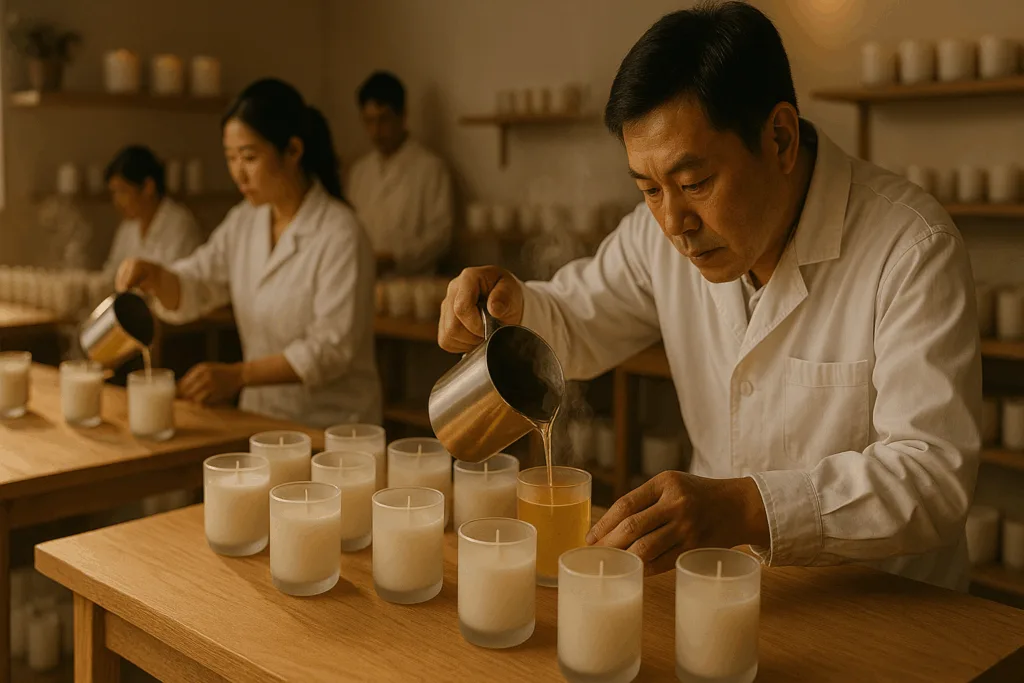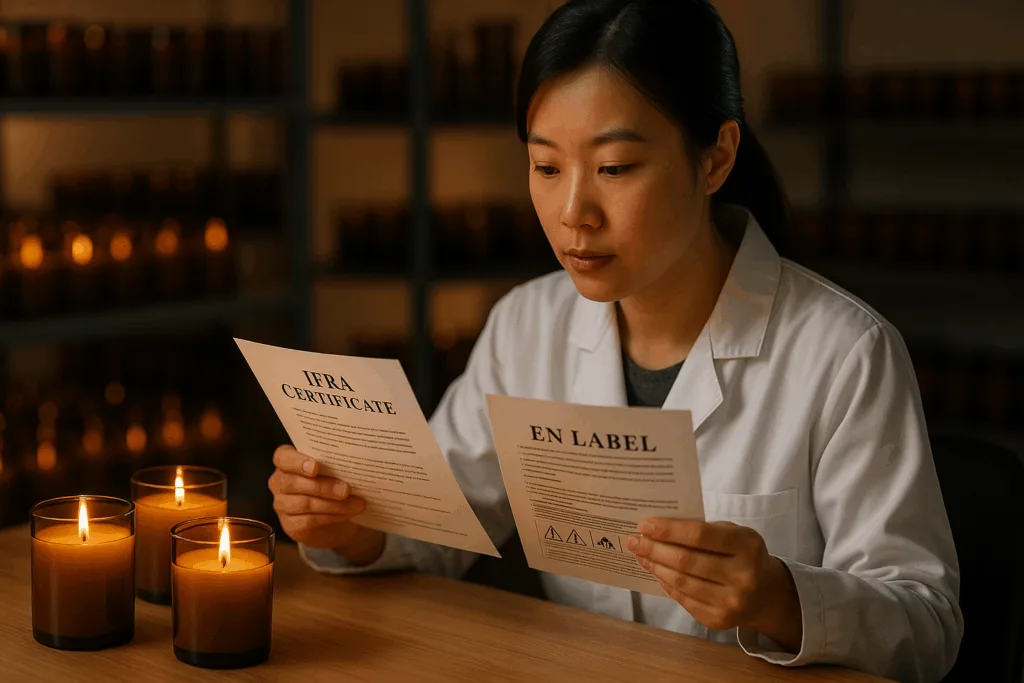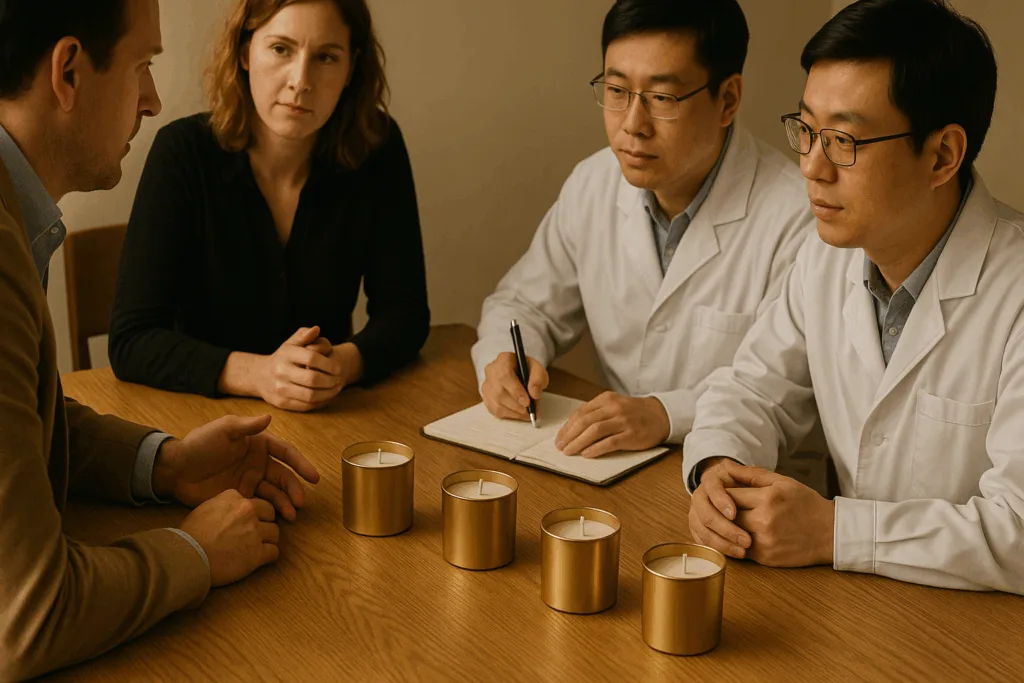Introduction: Why “5 Mistakes to Avoid When Choosing a Candle Factory in China” Determines Brand Longevity
In the world of home fragrance, every flame becomes a promise. The warm bloom of scent, the steady glow, the satin-smooth surface—each detail carries your brand’s reputation into living rooms, spas, and boutique lobbies. That is why 5 Mistakes to Avoid When Choosing a Candle Factory in China is more than a checklist; it’s a strategic safeguard. China anchors a major share of the global candle supply chain, offering depth of materials, scalable capacity, and craftsmanship that ranges from artisanal to fully automated. Yet abundance can be deceptive. Choosing the wrong partner risks inconsistent throws, smoky burns, vessel cracks, safety noncompliance, and reputational harm that lingers long after the wick has cooled.
At Circe Home, our design and manufacturing teams translate brand ethos into tactile, aromatic experiences. We speak the language of wax polymorphism, fragrance diffusion, and thermal management while honoring the poetry of a flicker that softens a room. This article distills calm, luxurious guidance into decisive actions—so you avoid the five pitfalls that silently tax margins, timelines, and trust.
Market Landscape: How China Shapes Global Candle Supply and Private Label Growth
China’s candle ecosystem spans coastal export hubs and inland craft workshops, with raw material pipelines feeding soy, coconut, rapeseed, beeswax, paraffin, and advanced blends. The result is a flexible platform for private label candles in China—from small-batch boutique runs to high-volume hospitality rollouts. For B2B buyers, the opportunity is scale plus specialization: fragrance labs that can reverse-engineer your hero scent, ceramic studios throwing custom stoneware, and glassworks capable of tight color tolerances and thermal-shock resilience.
Demand leans toward clean-burning formulas and minimal-packaging luxury. Brands seek consistent hot throw in open-plan spaces, cold throw that captivates at shelf, and vessels that feel like design objects. The winners pair scientific rigor with sensory grace. The outliers chase the lowest quote and eventually pay it back in returns, poor reviews, and damaged LTV. The Chinese supply base can deliver either outcome—your diligence decides which.
The Stakes: Translating Brand Essence Into Flame, Throw, and Texture
A candle is chemistry wrapped in emotion. Wax crystallizes, fragrance partitions, wicks mediate oxygen, and vessels dissipate heat—each variable alters the story your candle tells. If your manufacturer misreads your brief or lacks the lab discipline to tune variables, the result won’t just be an imperfect candle; it will be an imperfect brand memory. Luxury is felt in the slow, even melt pool, the whisper-quiet crackle of a wood wick, the velvety surface that resets after burn. Inconsistent suppliers rarely deliver this poetry twice.
Circe Home builds specifications that communicate intent in measurable terms: viscosity ranges, fragrance load windows, wick series and trims, vessel tolerances, and pass/fail criteria for sooting and tunneling. When your standards live in data as well as design language, your product scales without losing soul.
Mistake 1: Skipping Compliance—Certifications, Testing, and Legal Labelling
Compliance is the invisible shield that keeps launches on time and products on shelves. Skipping it is the fastest path to seizures at customs, delistings, or recalls. Require proof and retain copies.
What to request and verify
- ISO 9001 (quality systems) and ISO 14001 (environmental stewardship).
- IFRA statements and allergen disclosures for every fragrance.
- EN 15493/EN 15494 (soot & labelling) for EU, ASTM F2417/F2058 for US.
- REACH, CPSR (where applicable), CLP/GHS-compliant labels and pictograms.
- Child safety and cautionary statements aligned with destination market.
Controls that catch problems early
- Third-party burn testing on first orders and after any material change.
- Golden sample (signed, dated) kept at factory and brand HQ.
- Change-control SOP when switching wax lots, wick series, or vessels.
Circe Home stance: No certificate, no production. We pair paperwork with on-bench trials to verify what the PDFs claim. The outcome is a candle that travels smoothly from lab bench to living room.
Mistake 2: Price-Only Sourcing—When Cheap Candles Cost the Most
Unit price should be the last decision, not the first. Factories can hit almost any target—by thinning fragrance, using filler wax, skipping cure times, or selecting brittle glass. The invoice shrinks while your risk surges.
True cost model
- Returns and refunds from tunneling or soot = revenue erosion.
- Reputation damage across marketplaces = suppressed conversion.
- Freight for replacements + rush fees = margin drag.
- Sleepless nights and misaligned launches = opportunity cost.
Value-first sourcing
- Pay for stable wax systems (e.g., soy–coconut with controlled melt).
- Specify minimum fragrance load and acceptable variance.
- Budget for burn/batch testing as a standard line item.
- Insist on cure windows that protect throw and appearance.
Sensory litmus: An exquisite candle sounds quiet, smells dimensional, and feels silky under the fingertips. If samples feel rushed, trust your senses.
Mistake 3: Underestimating Wax Science and Fragrance Engineering
Wax is a polymorphic solid; crystals form and reform as they cool, affecting opacity, adhesion, and scent diffusion. Fragrance molecules differ in volatility and polarity, influencing how they bind to wax and release into air. Under-engineered candles can frost, mushroom, or smell thin.
Engineering questions to ask
- What is the recommended fragrance load window for this wax?
- Which wick families pair with this vessel diameter and fragrance base?
- How do you control pour temps, room temps, and cure times seasonally?
- Can you demonstrate flashpoint compliance and stability data?
Circe Home practice: We prototype in triads—varying wick, pour temp, and fragrance load—then ladder up to environmental chambers that simulate humid tropics and dry winters. The result is a formula that behaves like itself in different worlds.
Mistake 4: Communication Gaps—Specs, Samples, and Cultural Fluency
Great factories are fluent in detail. Great buyers are fluent in empathy. Miss either, and you invite delays.
How to speak clearly
- Use a one-page spec sheet: wax, wick code, vessel ID, fill weight, pour temp range, cure time, fragrance %, labeling rules, pass/fail criteria.
- Approve a full “production intent” sample set (retail-ready) before PO.
- Hold weekly video check-ins during first 2–3 orders; share screen and update a live action log.
- Assign bilingual project managers who translate not just words but intent.
Cultural note: Directness varies. Ask open questions, invite concerns, and reward proactive risk flags. A partner who brings bad news early is your best insurance policy.
Mistake 5: Limited Customization—Packaging, Vessels, and Brand Storytelling
A candle is sculpture plus scent. If your supplier offers only stock jars and matte-black boxes, your brand becomes forgettable. Demand range and craft.
Customization menu
- Vessels: satin-frosted glass, tinted translucent, stoneware with reactive glazes, brushed aluminum with soft-touch lacquer.
- Lids: natural cork, oiled walnut, anodized metal with deboss, ceramic domes.
- Labels: foil, blind emboss, UV spot, textured cotton papers.
- Boxes: rigid magnetic, slipcase, die-cut windows, FSC recycled boards, algae inks.
- Refills: engineered inserts that snap into branded keepsake vessels.
Story-first design: Choose materials that sound like your brand—quiet, grounded, nature-forward. The goal is a handfeel that whispers luxury before the wick is lit.
Due Diligence Toolkit: Audits, SOPs, and Golden Samples
Audit beyond the showroom. Walk raw-storage rooms; check fragrance drums are sealed and dated. Inspect wick racks for order and cleanliness. Verify MSDS folders are complete and accessible.
Your kit
- Factory profile + capacity table (lines, daily pours, peak season plans).
- SOPs for receiving, batching, pouring, finishing, and pack-out.
- Traceability map from fragrance lot to finished SKU.
- Golden sample library with tamper seals and digital photos.
- Corrective Action Request (CAR) template and close-out timeline.
OEM vs. ODM: Picking the Right Engagement Model for Your Roadmap
| Model | What You Get | Best For | Risk Profile |
| OEM | Factory manufactures to your exact spec, your IP | Established brands with defined DNA | Higher NRE/tooling, highest control |
| ODM | Factory’s catalog + light customization | Fast launches, test markets | Lower upfront, shared aesthetics |
Circe Home blends models: start ODM to validate demand, then shift to OEM with custom vessels, fragrances, and refill systems as velocity grows.
Material Guide: Soy, Coconut, Beeswax, Rapeseed—How to Match Wax to Intent
- Soy (hydrogenated): Creamy finish, moderate hot throw, may frost in cold; sustainable, beloved by eco-luxury.
- Coconut blends: Lower melt point, excellent scent throw, silky surface; premium feel.
- Beeswax blends: Natural ionization, long burn, golden hue; pairs with herbaceous, resinous notes.
- Rapeseed (canola): European-favored, great adhesion, stable diffusion.
- Paraffin or hybrid luxury paraffin: Razor-sharp glass adhesion, brilliant throw; requires soot controls.
Choose the matrix that serves your brand narrative: soft spa hush, sun-warmed orchard, alpine lodge glow. Circe Home tunes blends for performance and planet.
Wick Mastery: Cotton, Wood, Cores, and Flame Geometry
Wicks are engines. Diameter, braid, core, and coating shape capillary action and flame shape. Too small, the candle tunnels; too large, it soots and mushrooms.
Guidelines
- Measure inner diameter at fill line; select 2–3 candidate wicks.
- Test with your strongest and weakest fragrances—wick to the stronger.
- Wood wicks add crackle; specify moisture, thickness, and booster slits.
- Trim spec belongs on the warning label and any included care card.
Fragrance Systems: IFRA, Allergen Lists, and Cold/Hot Throw Protocols
Fragrance is architecture. Top, heart, and base notes unfold at different temperatures and airflows.
What we document
- IFRA category and max usage %.
- Allergen declarations (EU Annex III).
- Flashpoint and storage temp ranges.
- Cold throw (24–72h post-pour), hot throw (2–3 burns), aging study (30 days).
We build olfactory briefs with mood boards and raw-material callouts (amber, cedar, bergamot, vetiver). The aim is a fragrance that feels like a room’s intention.
Vessels & Lids: Glass, Ceramic, Metal—Thermal Shock and Aesthetics
Vessel safety is non-negotiable. Thermal-shock resistance, wall thickness, and annealing quality keep heat where it belongs. We require sample lots that undergo hot-fill trials and thermal cycling.
Selection notes
- Thick-walled glass prevents hotspots; test for microbubbles.
- Ceramics showcase glaze artistry; tolerances must fit refill programs.
- Metals need interior lacquers compatible with fragrance and heat.
- Lid vents and gaskets prevent vacuum lock and protect throw during storage.
Packaging That Converts: Unboxing, FSC Papers, and Refill Programs
Your box is the first touch. Texture, typography, and ease of opening define how luxury feels before flame.
Wins that matter
- FSC and recycled boards with tactile emboss.
- Molded pulp or mushroom inserts that cradle vessels and cut plastic.
- QR care cards linking to burn guides and playlists.
- Refill-friendly architecture: inserts, collars, and messaging that invite repeat purchase.
Quality Control: Burn Tests, Soot Index, and Tunnel Prevention
Sampling plans (AQL) align with risk. For first orders, increase inspection frequency.
QC stack
- Visual: surface smoothness, adhesion, centered wick, label alignments.
- Dimensional: fill weight ± tolerances, vessel internal diameter.
- Functional: 3 × 4-hour burns, full melt pool by burn 2–3, soot index within spec.
- Post-burn: residue, jar temperature mapping, relight behavior.
Sustainability Uplift: Eco-Wax, Traceability, and Recyclability
Sustainability is strategy, not slogan. We track origin of waxes, ensure palm derivatives are RSPO-certified when used, and design for second life: vessels that serve as storage jars or vases.
What we prioritize
- Bio-based waxes with transparent sourcing.
- Recyclable, refillable, or reusable components.
- Low-VOC inks and water-based adhesives.
- Consolidated shipments and carbon reporting on freight.
Logistics & Lead Times: Forecasting, Incoterms, and Buffering Peak Seasons
Candles are seasonal; production windows tighten around Q4. Build buffers.
Planning map
- Sampling & approvals: 3–5 weeks.
- Production: 25–40 days (factor cure).
- Ocean transit: 25–40 days; air for emergencies only.
- Incoterms: FOB for control, DDP for simplicity—decide by team bandwidth.
- Carton tests: drop and vibration for e-comm durability.
Hidden Costs: Tooling, Fragrance Dev, Compliance, and Damages
Avoid surprises by itemizing:
- Custom vessel molds and MOQs.
- Fragrance dev fees + stability testing.
- Third-party lab testing and certification renewals.
- Spare cartons and overage for transit damages.
- Label plate charges and color-matching rounds.
Technology in Chinese Factories: Automation, Laser Wick-Set, MES Data
Modern plants use automated pour lines with PID temperature control, laser wick-centering, and MES dashboards that log batch parameters. Data-rich runs are repeatable runs. Ask for exports of line data tied to your PO number.
Red Flags On-Site: What Your Eyes, Ears, and Nose Can Catch
- Strong solvent smells in filling rooms (poor ventilation).
- Dust on empty vessels or open boxes.
- Unlabeled drums or expired fragrance lots.
- Shrug responses to spec questions.
- No quarantine area for nonconforming goods.
Trust the senses that your brand sells: if the factory feels rushed or chaotic, the candle will, too.
Case Study 1: Nordic Wellness Brand—Consistency Across Climates
Brief: spa-like calm with herbaceous top notes and a mineral base, sold in Scandinavia and the Gulf. Challenge: climate spread from cold-dry to hot-humid.
Action: soy–coconut blend tuned for slower melt in heat; wick stepped up one size for dense resin base; vessel thickened by 2mm; ship with care cards. Outcome: 99.8% pass rate, reviews mention “clean aura” and “silent, even burn.” Reorders doubled within two seasons.
Case Study 2: Hotel Collection—Silent Luxury with Refillable Ceramics
Brief: five-star hotel scent program with lobby signature and room-side ritual. Design: hand-thrown stoneware vessels, matte eggshell glaze; refill inserts ship quarterly.
Action: proprietary fragrance built with cedar, iris, and ambrette; wood-wick crackle tuned to whisper-level. Outcome: housekeeping reports less soot, guests purchase refills via QR; brand extends into reed diffusers using same olfactive DNA.
Circe Home Process: From Brief to Palletized Perfection
- Discovery & Scent Strategy: mood boards, brand archetype, audience rituals.
- Formula Prototyping: wax matrix trials, wick arrays, temperature ladders.
- Design & Packaging: vessel CMF (color–material–finish), box dielines, refill architecture.
- Compliance & Testing: IFRA, CLP/GB standards, burn series, transit tests.
- Production & QC: MES-logged batches, AQL inspections, golden-sample sign-off.
- Logistics & Launch: carton optimization, pallet configs, freight and carbon footnotes.
- Aftercare: VOC monitoring on repeat lots, seasonal adjustments, continuous optimization.
Consumer Psychology: How Scent Rituals Drive Retention and AOV
Scent is memory’s shortcut. Ritual packaging cards that suggest “evening unwind” or “morning clarity” transform a candle from décor into a habit. Refills convert one purchase into many; layered products—room sprays, diffusers—raise AOV while maintaining olfactive coherence. The right factory enables this ecosystem with consistent bases and components.
FAQ—Candid Answers for B2B Buyers
What certifications should a candle factory in China show before production?
ISO 9001/14001, IFRA statements per fragrance, EN/ASTM safety testing relevant to destination markets, and CLP/GHS labeling readiness. Keep copies on file for each PO.
How do I avoid the 5 mistakes to avoid when choosing a candle factory in China?
Prioritize compliance, value over price, material and fragrance engineering, structured communication, and deep customization capacity. Use audits and golden samples to lock consistency.
Can factories truly match my hero scent?
Yes—with skilled perfumers and GC-MS guidance. Expect 2–4 rounds. Demand IFRA compliance and run stability tests across temperature swings.
What MOQs and lead times should I expect?
Common MOQs range 500–3,000 units per SKU. Plan 25–40 production days plus cure and transit. Peak season needs additional buffer.
Is refillable packaging realistic for wholesale?
Absolutely. Engineer vessels for safe, easy insert replacement and message the ritual; refills build loyalty and reduce waste.
Do wood wicks cause more soot?
Not when matched correctly. Choose the right thickness and ensure customer trimming guidance; test with your strongest fragrance.
How does Circe Home reduce freight risk?
Carton drop/vibration testing, buffered pack-outs, humidity indicators where needed, and clear Incoterms. We design for journey as much as destination.
Conclusion & CTA: Partner with Circe Home for Safe, Lush, Sustainable Scale
Choosing the right partner is choosing the memory your product leaves behind. With China’s vast capability, 5 Mistakes to Avoid When Choosing a Candle Factory in China becomes your compass. Circe Home pairs lab discipline with lyrical design—eco-forward waxes, refined vessels, compliant labels, and packaging that hums with quiet luxury. Let’s translate your brand into light: calm, enduring, and unmistakably yours.
Let’s collaborate. Share your brief, target launch, and preferred materials. We’ll return a draft spec, timeline, and sampling plan that keeps your margins confident and your customers enchanted.





